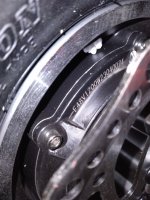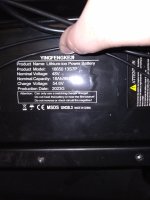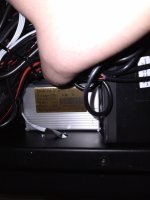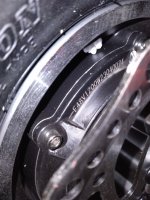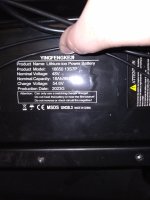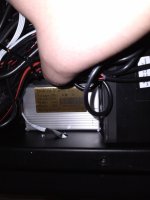To handle the hills it doesn't need mroe speed, it needs more torque.
Sometimes what you do to get the one gives you more of the other as a byproduct, but if you want both, you'll have to upgrade the parts that provide each one.
Is the max wheel speed the same when it is offground (unloaded) as it is when riding on a flat road with no wind?
If so, the ocntroller is probably speed limited, often in a way the end user can't bypass. THis is often the case with scooters/ebikes/etc, legal requirements in many locations won't allow a faster speed so the electronics have to prevent it. (some places have hefty legal consequences for riders of these things that aren't limited this way, so you might want to look into that before making it faster, if that matters to you).
If it goes a lot faster unloaded then it's just not pwoerful enough to go that fast when riding. I'd guess that the power avialable could handle up to at least 20-25mph (on flat ground no wind), which is 32-40kmh, but that doesn't mean the system is built ot be able to do it.
If it's not enough power to go faster, or up the hills, you'd need a higher current controller, and possibly a higher current capability battery (if the one you have has problems with the bigger controller once that's installed).
If you need more than 1200w to do the job it has to do for you, the motor may or may not be ablet o handle that, it's prbably good for 1500-2500w bursts of a few seconds to a few minutes, dependign on conditions.
The motor may also be wound to only go about that speed, in which case to go faster you would need either a new motor that's built to go as fast as you want in the size wheel you have at the voltage you already have, or you'd need a new controller and new battery that are both higher voltage by enough to drive the existing motor to that speed.
Watt ratings of systems / motors are not really accurate (most not even close to reality) but the 48v1200w marking on your motor probably means that it is intended to be run at 48v to get a certain rpm (not listed on it), and probably will have a max continuous power of 1200w when run at that full speed (when it's run slower, it will have higher current and higher heating, less efficient, the slower it is at that higher powerr the faster it heats up).
The controllers says it's 48v 20A, which gives you almost 1000w of continuous output power.
The battery does not list it's current rating, just that it's a 48v battery 13s7p 18Ah, so it would probably be able to handle 20Ah easily, assuming it's built correctly of good cells. How much more current it could take, we can't know without testing, which you would be doing if you upgrade the controller to a higher current version (if it can't take it, you'd need a new battery that can). If it's a good battery, it should take at least 36-40A, but there's no way to know how well made it is without testing to find out how it behaves under the higher load.
You can go to the ebikes.ca motor / trip simulators and experiment iwth it to learn how all these things work together, to get a better idea of how much power you will probably need to move the total vehicle/rider/etc weight up the worst-case slope you have at whatever speed you need it to do this.


